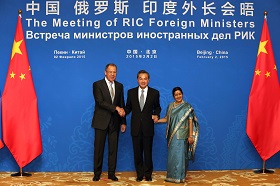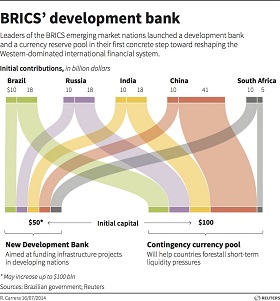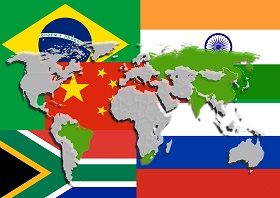BRICS: Union of Reformers and National Interests
(no votes) |
(0 votes) |
Doctor of Economics, Ph.D. in History, School of International Relations, Saint Petersburg State University
Ph.D. in History, School of International Relations, Saint Petersburg State University
The BRICS Forum is a difficult subject of analysis within the narrow framework of studying international integration associations. BRICS does not have a structure, a development strategy or mechanisms for implementing decisions. There is much debate about the role and viability of such an association. There is no doubt that BRICS has the opportunity to transform itself into an alternative pole of the global and political architecture. The question is whether the member countries can bring their national interests in line with those of the group as a whole.
The BRICS Forum is a difficult subject of analysis within the narrow framework of studying international integration associations. BRICS does not have a structure, a development strategy or mechanisms for implementing decisions. There is much debate about the role and viability of such an association. There is no doubt that BRICS has the opportunity to transform itself into an alternative pole of the global and political architecture. The question is whether the member countries can bring their national interests in line with those of the group as a whole.
The Causes and Effects of Developing Monetary and Financial Cooperation among the BRICS Countries
Experts are divided as to whether or not the BRICS countries have common interests. But most agree that the member nations view the existing model of the global financial and economic architecture as being inequitable. The main unifying goal of the BRICS organization is to bring about reform of the international financial system so that it is more in its favour. There are different views about what the BRICS members are looking to gain from developing cooperation within the organization:
1) To destroy the dominance of the United States and its allies in the International Monetary Fund (IMF) over the global financial system (the political version):
The idea of challenging the hegemony of the United States was originally attributed to Russia. Moscow became the catalyst for the formation of the BRIC community towards the end of the 2000s. But now it is China that is leading the way. Beijing’s efforts to reform the IMF are complimented by attempts to internationalise the yuan.
2) To protect itself from the adverse effects of the economic slowdown in the G7 countries (the economic version):
The main unifying goal of the BRICS organization is to bring about reform of the international financial system so that it is more in its favour.
The U.S. mortgage crisis and the EU budget crisis convinced the BRICS countries that these processes posed real danger to their national economies. This is why the BRICS states are placing their stock on diversifying economic ties outside the United States–Japan–Western Europe triad.
3) To replace the hegemonic stability of the Washington Consensus with the new values of the Beijing Consensus (the politico-economic version):
The existing liberal model of the global economy functions as a result of the hegemony of one country. The United States provides access to its market in return for countries carrying out liberal reforms and opening up their own national markets. The economic model of the Washington Consensus is in crisis. The Beijing crisis offers the world new ideals: inclusive economic growth, economic development with the guarantee of the inviolability of sovereignty, a commitment to innovation and experimentation (special economic zones), and the accumulation of instruments of asymmetric power (trillions of dollars of foreign currency reserves).
Foreign currencies are the concentrated expression of accumulated state power. This is why the negative effects of unipolarity are valid for the world of finance as well. Establishing economic multi-polarity should be accompanied by a more complicated monetary and financial architecture by reducing the weight of the U.S. dollar in international finance. The global economy will become more balanced if it starts to rely upon a number of power centres.
In its Annual Report 2011, the World Bank predicted that the yuan would be among the currencies that would achieve equal status with the U.S. dollar by 2025. This would lead to the BRIC countries, Indonesia and South Korea occupying a 45 per cent share of the global economy within the next 14 years, up from its 2011 level of 36 per cent. An autumn 2014 report by the United Nations Statistical Commission and the World Bank officially acknowledged that China had become the largest economy in the world.
The strength of any economic centre directly depends on the liquidity of that centre’s currency in the global system. BRICS is a new centre of power, although it is unlikely that a single BRICS currency is going to appear within the next quarter of a century. It is more likely that strong regional centres will be formed around the currencies of all five BRICS countries.
Reforming the IMF and Transitioning to Payments in National Currencies
The priorities of BRICS are focused on the fundamental structures of the global financial system – the IMF and the International Bank for Reconstruction and Development (IBRD). Joint initiatives of the BRICS countries to revise the quota in these structures in favour of developing countries have encountered opposition. Washington seeks to keep a firm grip on the IMF; the United States remains the only global power that has not ratified the 2010 IMF quota reform. This is why the most important area of the work of BRICS is to form alternative foreign currency and financial instruments. The general financial structures of the BRICS countries guarantee stability against the background of increasing instability. The emergence of major financial institutions such as the New Development Bank (the BRICS Bank) must certainly affect the activities of the IMF. Under the control of the BRICS countries, the bank carries out the same functions as the IMF and the IBRD, but for developing countries. However, when faced with opposition from these structures, the BRICS format acquires a distinctive “anti-Western” character. Such a scenario is not in the interests of most of the group’s members. Accordingly, the leaders of the BRICS countries quite deliberately stress that the New Development Bank is not at odds with the IMF and the IBRD. The very appearance of the BRICS Bank is another way of putting pressure on the United States to speed up reform of the IMF.
As for implementing the framework agreement on the creation of a Foreign Currency Reserve Fund, the G20 Summit in Brisbane in November 2014 saw the BRICS leaders step up the process of developing the mechanisms for cooperation. At the same time, the BRICS countries strengthened their position within the G20 thanks to such countries as Indonesia, Mexico and Argentina.
The priorities of BRICS are focused on the fundamental structures of the global financial system – the IMF and the International Bank for Reconstruction and Development (IBRD).
The idea to use national currencies in mutual settlements was supported by the BRIC countries at its first summit in Yekaterinburg back in 2009. However, abandoning the U.S. dollar in mutual settlements is not an easy task. Currently, the transition to payments in national currencies between BRICS countries is poorly implemented. The BRICS Bank intends to carry out operations in U.S. dollars. Right now, payments in national currencies only apply to bilateral trade in energy products between Russia and China. At the same time, however, the sanctions levied against Russia have accelerated the process of developing such mechanisms within the BRICS framework.
The Trade-Off between Uniting Interests and Existing Differences
The creation of the BRICS Bank revealed a number of differences between the partners. At the BRICS Summit in Durban, South Africa, in 2013, the Chinese side put forward the idea that the share capital of each country in the bank should be proportionate to their GDP. China’s GDP far exceeds that of all the other BRICS countries. There were fears among the remaining four countries that China was attempting to bring the new bank under its control. In the end, the issue was postponed. If the countries had failed to come to a consensus on the issue a year later, then we could have started about the failure of the BRICS’ economic strategy. The parties only reached an agreement in principle on the eve of the 2014 summit in Fortaleza, Brazil. The impact of the existing disagreements on the dynamics of cooperation are particularly evident if you compare the speed with which this BRICS project was implemented with the analogous Chinese project to set up the Asian Infrastructure Investment Bank (AIIB).
The presence of common currency and financial goals does not yet shape the conflux of national interests and geopolitical strategies of the BRICS countries. At the same time, national interests are for the most part different from the general interests of the group, and rarely coincide. Two disagreements hamper the development of the BRICS group at the global and national levels.
1) Reform of the UN Security Council (the global level) :
The general financial structures of the BRICS countries guarantee stability against the background of increasing instability.
Given their political and economic positions, India and Brazil do not feel that the current structure of the UN Security Council adequately reflects contemporary reality. Their concern stems from the fact that they must rely on Russia and China to represent the interests of the BRICS countries at the Security Council. China does not want to grant India equal status and has suggested alternative methods for expanding the Security Council without giving new members the right to veto. For New Delhi, this option is unacceptable, as it sees the right to veto as a key element of permanent Security Council membership. Russia continues to support India’s position in its official statements, but acknowledges that it is a complicated process. It would be difficult to expand the Security Council without also accepting applications from Japan and Germany. Japan’s candidacy, however, is unacceptable to China. And increasing the number of permanent members by accepting another Western country would serve no practical purpose for Russia. As a result, no positive developments are on the horizon.
During his speech at Fortaleza, Prime Minister of India Narendra Modi emphasised the need to reform the United Nations, pushing the matter of reforming the IMF onto the back burner. In their final declarations, the BRICS countries continue to emphasize the dominant role of the United Nations in resolving international crises. Similar views on the structure of international security are an integral part of the foundation for political cooperation within BRICS. This is why the topic of UN reform is essential for strengthening the partnerships between the countries that make up the group. By recognizing India’s special position, Russia can influence China. However, increased interaction between New Delhi and Washington, as well as the “Nuclear Deal” signed between the two, are preventing Moscow from taking the appropriate decisions.
2) Disagreements between India and China (the national level) :
India and Brazil do not feel that the current structure of the UN Security Council adequately reflects contemporary reality. Their concern stems from the fact that they must rely on Russia and China to represent the interests of the BRICS countries at the Security Council.
The range of disagreements between the People’s Republic of China and India are not restricted to territorial disputes over the Aksai Chin and Ladakh regions and the legitimacy of Arunachal Pradesh’s becoming an Indian state. However, it is impossible to talk about strategic relations between the two countries while these border disputes remain. Geopolitical tensions stem from the increased activity of China in its relations with Pakistan and Afghanistan. There is perhaps an economic explanation behind Beijing’s readiness to form partner relations with India’s western neighbours (logistical access to Central Asia, infrastructure projects and mining operations). Nevertheless, India is seriously concerned about the rapprochement between China and Pakistan, and especially between China and Afghanistan, as it upsets the balance of powers in the region and puts China’s strategy in South Asia under the microscope.
The healthiest aspect of mutual relations between New Delhi and Beijing is in the trade and economic sphere. However, the growing trade imbalance increasingly affects these relations. Indian manufacturers fear competition from Chinese-made made products on the domestic market. The dynamics of import and export between the two countries has led towards a steady increase in the trade balance in China’s favour. In 2014, India’s trade deficit grew from $36 billion to $48 billion, with total trade standing at $72.4 billion. The New Silk Road concept only further increases China’s penetration into South-East and Central Asia, and India could be forced out of the traditional regional markets.
Advantages and Disadvantages of the BRICS Format and the Question of Institutionalization

Vyacheslav Belokrenitskiy:
Russia-India-China: An Intricate Love Triangle to
Counter the United States?
From the legal point of view, BRICS is not an inter-governmental organization. The informal negotiation-style format of BRICS is in essence a geopolitical discussion club. At the group’s summits, the leaders of the BRICS countries make decisions that require their governments to work closely together. As such, the BRICS format is very similar to that of the G7. But there are differences. In the G7, the position and strategy of the White House dominates. The United States is the core around which the remaining countries unite in terms of ideology and economics. From the very outset, the BRICS format has ruled out the possibility of such a leader emerging. In keeping with their national interests, neither Russia not India recognize China as the leader of the group when defining its development strategy. This is why the BRICS format has more contradictions and inconsistencies now than ever.
One of the drawbacks of BRICS is the fact that it is an international club with an unclear legal foundation. Because there is no leader, interaction between the member countries is largely dependent on the nature of bilateral relations. Due to the contradictions and differences in the national interests of the parties mentioned earlier, the level of foreign policy cooperation between the countries is low. On the whole, we can say that the views of the BRICS countries converge only on the matter of the international security architecture. At the same time, decisions made at summits have failed to provide any specific joint actions on consolidating multi-polarity in the world. It should be emphasized that none of the other BRICS countries are interested in Russia using the BRICS platform to give the forum an anti-Western character. They have thus far maintained neutrality in their assessment of the situation in Ukraine. Any initiative aimed at politicizing the BRICS agenda at the upcoming summit in Ufa will be met with scepticism.
In its current format, BRICS allows a number of problematic issues between its countries to be swept under the carpet. However, the institutionalization of BRICS can help to build a more effective international relations architecture. Some Russian experts believe that establishing a system of bureaucracy within BRICS will pave the way for ongoing cooperation and give BRICS a more clearly defined structure. The question is whether the other BRICS members are prepared to do this. In particular, the initiative to set up a BRICS Parliamentary Assembly was shot down by India, which opposes the “excessive formalization” of the group.
Recommendations
The systematic development of the BRICS group should begin with the gradual formation of a long-term economic strategy. As the driving force behind the process, Russia needs to focus on making this a reality during the BRICS summit to be held on its soil. Our recommendations concern possible Russian initiatives at the upcoming BRICS summit in Ufa on July 9–10, 2015:
- Step up the process of developing a long-term economic strategy for BRICS countries;
- Focus on agreeing mechanisms for transitioning to a system of mutual settlements in national currencies between BRICS countries and on the establishment of the Foreign Currency Reserve Fund;
- Submit for discussion a possible model for the institutionalization of BRICS as part of the group’s economic strategy;
- Discuss mutually acceptable options for the reform of the United Nations Security Council, taking the interests of India and Brazil into account.
1. Global Development Horizons 2011. Multipolarity: The New Global Economy. World Bank, Washington, D.C. May 2011, p. 38.
2. Legacies, Clouds, Uncertainties. World Economic Outlook. IMF: Washington, D.C. October 2014.
3. Ministry of Foreign Affairs: The Need to Create a BRICS Banks was Prompted by the U.S. Delaying IMF Reforms // ITAR-TASS, August 28, 2014. URL: http://tass.ru/politika/1405314 (in Russian).
4. BRICS Countries Agree to Appoint New Development Bank Head before Summit in Russia // RIA Novosti, November 15, 2014. URL: http://ria.ru/economy/20141115/1033424874.html (in Russian).
5. Lavrov: Russia Will Look For Ways to Ratify BRICS Decisions on Reforming the Financial System // ITAR-TASS, October 20, 2014. URL: http://tass.ru/politika/1518969 (in Russian).
6. Joint Statement by the Leaders of the BRIC Countries. June 16, 2009. URL: http://news.kremlin.ru/ref_notes/209 (in Russian).
7. Gabuyev, A. A Fund of Obstacles // Kommersant. Vlast. URL: http://www.kommersant.ru/doc/2155186 (in Russian).
8. A World Bank Group Flagship Report. Global Economic Prospects. January 2015, p. 4.
9. BRICS Summit: What Narendra Modi said // India Today, July 16, 2014.
10. Factbox: The U.S.–India Nuclear Deal // REUTERS, February 3, 2015. URL: http://in.reuters.com/article/2015/02/03/india-obama-nuclear-idINKBN0L70AE20150203
11. India–China Trade Deficit Swells 34% to $48 billion // The Hindu, May 13, 2015.
12. BRICS Neutrality on Ukraine a Diplomatic Win for Putin // REUTERS, July 15, 2014. URL: http://in.reuters.com/article/2014/07/14/us-brics-summit-putin-idINKBN0FJ2MV20140714
13. Russia Supports Turning BRICS into a Full-Format Cooperation Mechanism // ITAR-TASS, April 1, 2015. URL: http://tass.ru/politika/1870264 (in Russian).
14. India Puts Brakes on Russian Project to BTICS Create Parliamentary Assembly // RBC, June 8, 2015. URL: http://top.rbc.ru/politics/08/06/2015/55758db99a7947dff14d5646 (in Russian).
(no votes) |
(0 votes) |






